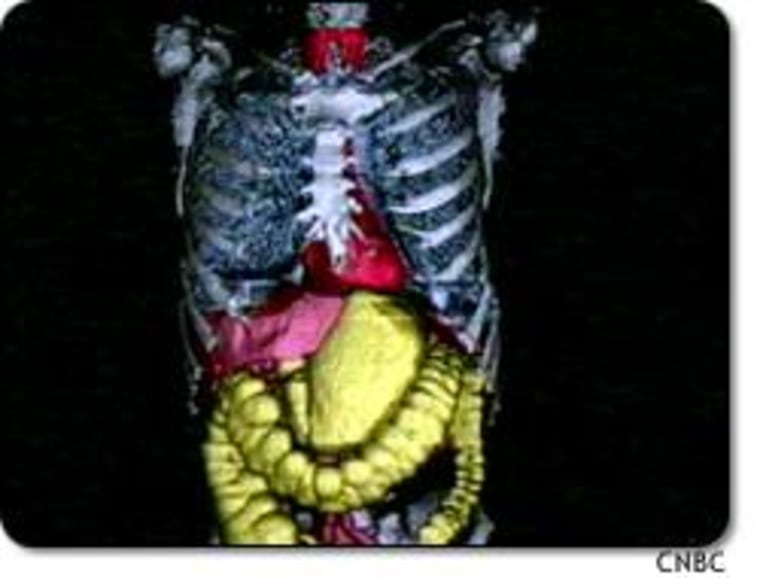One of the most controversial new medical procedures is the non-invasive full body scan, which promises a 3D computerized journey through your own body. But is this new technology the ultimate diagnostic prevention tool — or is scanning healthy people a waste of time and money?
As I entered the exam room at the Healthview Center for Preventive Medicine, it dawned on me I might be taking the annual physical of the future. The biggest challenge was holding my breath for 30 second intervals as the electron beam body scan, moving from my neck through my hip, took hundreds of pictures.
The machine was a more than 20-year-old, converted General Electric CT scanner. But it’s the breakthrough software that turns multi-layered, real-time images into a 3D journey though my body, providing far more detail than the traditional MRI. And all in about 20 minutes. It’s the only one of its kind in the country.
This revolutionary diagnostic tool is the brainchild of Dr. Harvey Eisenberg, a pioneering radiology specialist for more than three decades. In the last two years, more than 40,000 patients have been scanned, many of whom dreaded what the machine might discover.
“We view this as a kind of fear of death,” said Eisenberg. “Of course you want to know. You want to know. What makes it motivating instead of frightening is because you can do something about it.”
My own doctors have said that, for a 55-year-old male, my overall health is good. And there’s nothing wrong that a better diet and a little more exercise couldn’t cure. Did I really want to know what might be lurking inside?
Eisenberg’s answer is that with knowledge comes power.
“When we find diseases in their asymptomatic stages you can almost always slow it down, stop it, reverse it or cure it,” he said.
The scan costs about $800, with no guarantee of reimbursement from insurance. Eisenberg’s push to use scanners to look for disease in seemingly healthy people has put him at odds with much of the health care establishment. Some experts say body scans aren’t useful for the masses and won’t cut long-term health care costs across the board. One of the skeptics is Princeton University health care economist Ewe Eeinhardt.
“If you look at these body scans, sure, they may discover this and that,” he said. “But they also discover things that should be left alone. So, my view is that this will be a terrific tool for the neurotic upper classes.”
The technology was developed with nearly a decade of funding from the Department of Defense — not major medical technology manufacturers or the National Institutes of Health. And even as he battles for acceptance, Eisenberg is building another machine that could change medical diagnostics forever.
“This device that we’ve been funded by Defense to build will be a very expensive device but it will do a great deal more than anything we have today,” he said. “It may replace nearly $80,000 worth of tests, with a single test that will be done in minutes.”
When and if that machine becomes a reality, the road to an FDA blessing would require long, arduous study of essentially healthy people.
“You have to follow them long enough to see if they develop a disease,” said FDA Commissioner Dr. Mark McClellan. “That can be expensive and difficult and challenging from an experimental standpoint.”
As for me, the two-hour consultation after the body scan was an eye-opener, beginning with a slice-by-slice view of my vital organs.
“We took about 240 of these slices and we stacked them up into a volume, a three-dimensional volume that we can recreate in real time here,” said Eisenberg, as we reviewed my scan. “And of course we can colorize the anatomy and turn it into three-dimensional graphics where we’ll be looking at the anatomy like this.”
Nearly every patient scan reveals at minimum early signs of some disease. I was no exception: nothing life-threatening, no signs of cancer, an imminent heart attack or kidney disease. But I’ve been battling high blood pressure for nearly a decade.
What I saw for the first time was very early signs of calcified plaque in three different areas. The number and size, Eisenberg tells me, have the potential to block blood flow.
“This is not a lot of disease,” he said. “I typically would see a lot more than this. Still, you’ve entered the risk game by showing us there is disease there. But you’re at the low end of the spectrum for that.”
So, what do I have to do lower my risk profile? The answer is no surprise: better diet, more exercise, and less stress. But Dr. Eisenberg says what a body scan does is help you mobilize the real agent of change: your mind.
(CNBC's Steve Lewis contributed to this report.)
